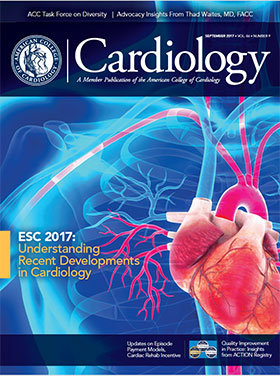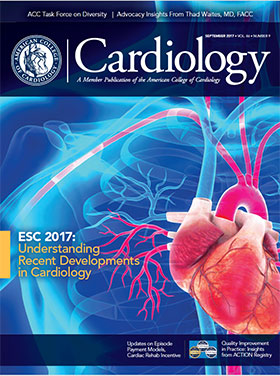Older STEMI patients who fit into the World Health Organization’s normal weight or extreme obesity body mass index (BMI) categories are more likely to have worse long-term outcomes than those who are mildly obese. The results of a study recently published in the European Heart Journal: Quality of Care & Clinical Outcomes address a knowledge gap in the obesity paradox and highlight the risks of an increasing aging population.
After matching Centers for Medicare and Medicaid Services longitudinal administrative data to patient data in ACC’s ACTION Registry, Ian J. Neeland, MD, et al., analyzed the long-term outcomes of 19,499 patients (mean age of 74.8 years) who had an acute STEMI between January 2007 and December 2011. The majority of the patients were white (90 percent) and more than half were men (62 percent). When stratified by BMI, 30 percent were normal weight, 41 percent overweight, 19 percent mildly obese, 6 percent moderately obese and 3 percent extremely obese. Read More >>>
“As BMI increased, there was a significant trend towards younger age, female sex, black race, and less smoking (p < 0.001),” write the study authors. “Higher mean [socioeconomic status] SES and lower comorbidity were seen among those with normal weight/overweight whereas obese patients had lower mean SES and greater comorbidity, with a widening gap seen as BMI increases.”
Results also showed an association between increasing BMI, higher left ventricular ejection fraction at presentation and less in-hospital cardiogenic shock (p < 0.001). In regard to in-hospital major bleeding, the authors noted a U-shaped relationship, with rates highest at the extreme BMI categories (p < 0.001). However, the study authors did not find significant differences based on BMI for cardiac arrest, provision of antiplatelet, anticoagulation, statin or reperfusion therapy, door to balloon time or cardiac rehabilitation referral.
Within the three-year follow-up period, 15.3 percent of the total study population died and 27.3 percent experienced a major adverse cardiac event. Patients who were normal weight or extremely obese had lower odds of days alive and out of hospital (odds ratio [OR], 0.79; 95 percent confidence interval [CI], 0.68-0.90 vs. OR, 0.73; 95 percent CI, 0.54-0.99, respectively). A U-shaped association was also observed between BMI categories and mortality.
“The clinical implications of these findings are increasingly relevant given the static prevalence of obesity despite substantial clinical and policy efforts.” The authors underline how the results “have economic and patient-centered implications since increased rates of readmission and longer time in the hospital lead to higher costs and decreased quality of life.”
They conclude by emphasizing the “need for aggressive prevention and treatment for this high risk group,” and recommend further study “to discern the sociobiological mechanisms underpinning these observations.”
Neeland IJ, Das SR, Simon DN, et al. Eur Heart J Quality Care Clinical Outcomes 2017;3:183-191.
<<< Return to top




